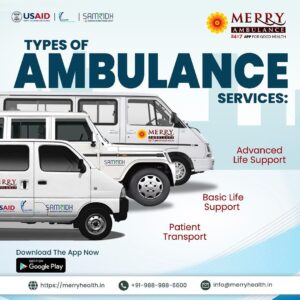
A shift in the global pathogen range has resulted in the spread of more infections, primarily vector bone. Climate change has accelerated the spread of these infections over the years. As a result, in the last few decades, there has been a sudden increase in medical ailments.
Rapid urbanization and changes in land-use patterns have long been major factors. As a result, societal behavior has gradually contributed to people adopting sedentary lifestyles. This resulted in costly long-term health issues.
For many people, an ambulance service means only pre-hospital care. However, if you dig deeper, you will quickly discover that medical patient transport services play a critical role in medical care, contributing to the health domain as a whole.
To combat the increasing pressures on the healthcare system, being resourceful is the only way out, and thus the concept of online ambulance service emerges. There will be an efficient transfer of patients thanks to the mobile booking of ambulances.
Medical patient transport services are not only profit-driven but also have a humanitarian philosophy that aids the treatment procedure, thereby accelerating the development of the health system in general.
Although ambulance services generally provide both emergency response and patient transfer on behalf of the health sector, their primary role is emergency pre-hospital medical care.
They make health services more accessible, especially after hours, and contribute significantly to telephone triage and telephone health services through sophisticated communications infrastructure. In recent years, it has become clear that increasing healthcare system pressures cannot be addressed solely by increasing resources, but must also be addressed through new service delivery methods.
To save the patient during critical conditions, both public and private emergency ambulance services are available. Every hospital and private EMS service typically has an ambulance operating system for immediate medical care. As a result of the development of ambulance transportation, there has been a consistent rise in the life-saving graph.
Patients with physical disabilities are unable to travel to the hospital in a standard vehicle. They won’t even be able to go for treatment or examination; Merry Health’s basic life support ambulance will suffice.
Specific emergency protocols must be followed when transporting a patient from their home to the hospital or from one hospital to another. Only the paramedics on the ambulance service have the basic knowledge to provide immediate medical care. They can provide the medical assistance that is urgently required.
The medical professionals who treat the patient first are the backbone of any ambulance service. They ensure that the vital signs remain stable until they arrive at the hospital, where the doctors will begin treatment.
They are trained and certified healthcare professionals who assist patients and provide them with the necessary medication in an emergency. They are trained to provide the most functional medical support, such as PCR, cardiac arrest restriction, bone fracture treatment, pain control, paralysis, complication during childbirth, blood loss management, and so on.
According to the most recent reports, there have been more intervention activities and a reduction in fatal incidents as a result of improvements in ambulance service. The most recent advancement has made the facilities seamless and has eliminated the patient block. An online booking system, a status board, tracking patient discharge movements, and timely alerts have all helped to keep the system on track. When the patient community is inaccessible or at a location with limited health practice, the ambulance service serves as a natural extension.
Ambulance services are the primary providers of a round-the-clock response to medical and trauma emergencies. They provide a disciplined and organized system that allows appropriately qualified health care workers to respond to potential or confirmed medical emergencies in a timely manner. Although major trauma centers provide medical retrieval teams, the ambulance communications center coordinates the team and rescue helicopter, which is usually crewed by intensive care paramedics.

